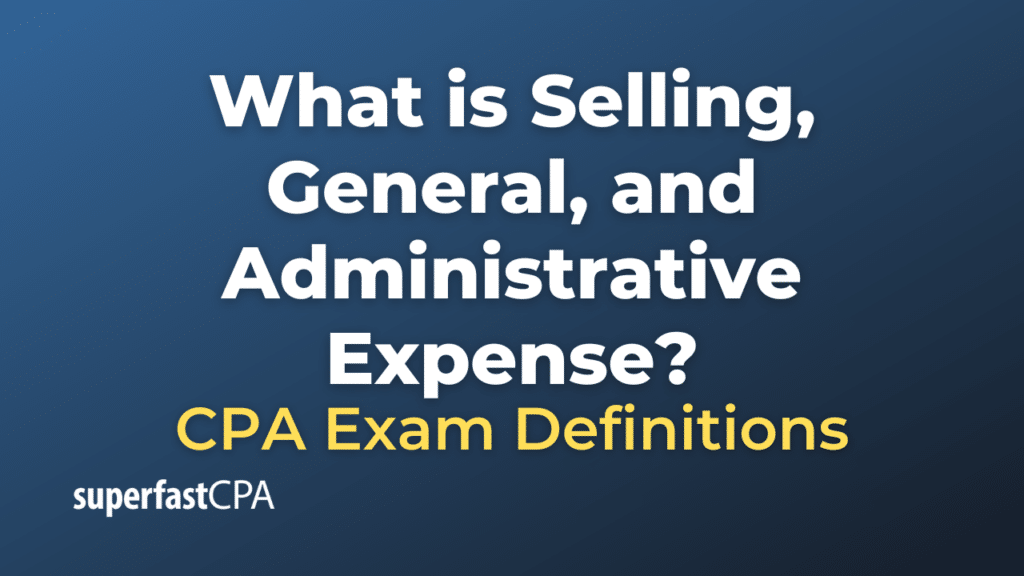Selling, General, and Administrative Expense
Selling, General, and Administrative Expense (often abbreviated as SG&A or SGA) is a line item on the income statement that encompasses all the non-production costs a company incurs. SG&A provides insights into how much a company spends to operate its main business activities, excluding direct costs associated with producing goods or services (like raw materials or direct labor).
SG&A typically includes the following expenses:
- Selling Expenses: Costs associated with promoting and selling the company’s products or services. This category might include:
- Sales salaries and commissions
- Advertising and marketing costs
- Travel and entertainment expenses related to sales
- Shipping and delivery costs
- Depreciation of sales equipment
- General Expenses: Costs related to the broader operational activities of a business. Examples include:
- Office salaries (management, administrative staff)
- Office supplies
- Rent or mortgage for office spaces
- Utilities (electricity, phone, internet)
- Insurance
- Legal and accounting fees
- Depreciation on office equipment and buildings
- Administrative Expenses: These are typically overhead costs that don’t fit neatly into the selling or general categories but are essential for running the business. Examples are:
- Executive salaries and bonuses
- Costs related to IT and software support
- Research and development (in some companies)
- Other indirect operational expenses
When analyzing the financial health and efficiency of a company, it’s important to monitor the SG&A expenses relative to sales revenue over time. A sudden spike in SG&A without a corresponding increase in revenue might indicate inefficiencies or other issues in operations. Conversely, a decreasing SG&A-to-sales ratio might suggest the company is becoming more efficient in its operations or is possibly under-spending in critical areas, which could impact future growth.
For some industries, especially service industries, SG&A expenses represent a substantial portion of total expenses since there might not be significant production or direct costs.
Example of Selling, General, and Administrative Expense
Let’s illustrate the concept of Selling, General, and Administrative Expense (SG&A) with a fictional example.
BrightTech Solutions Inc.
Income Statement Extract for the Year Ended December 31, 2023
Revenues:
- Software Sales: $1,000,000
- Consulting Services: $500,000
Total Revenues: $1,500,000
Cost of Goods Sold (COGS):
- Software production costs: $200,000
- Consulting direct labor costs: $100,000
Total COGS: $300,000
Gross Profit: $1,200,000
Selling, General, and Administrative Expense (SG&A):
1. Selling Expenses:
- Sales team salaries: $150,000
- Commissions: $50,000
- Advertising and promotion: $100,000
- Travel and client entertainment: $30,000
Total Selling Expenses: $330,000
2. General Expenses:
- Office rent: $100,000
- Utilities (electricity, internet): $20,000
- Office supplies: $10,000
Total General Expenses: $130,000
3. Administrative Expenses:
- Executive salaries: $250,000
- IT support and software licenses: $40,000
- Legal and accounting fees: $30,000
Total Administrative Expenses: $320,000
Total SG&A Expenses: $780,000
Operating Income: $420,000
(Note: Taxes, interest, and other non-operating expenses or incomes are not shown in this extract.)
From this example, you can see that BrightTech Solutions Inc. had total revenues of $1,500,000 for the year. After considering the direct costs (COGS) of producing software and providing consulting, the gross profit stands at $1,200,000.
Subtracting the combined SG&A expenses of $780,000 from the gross profit gives an operating income of $420,000 for the year. This operating income figure is before considering other factors like taxes, interest expenses, and other non-operating items.
By examining SG&A, stakeholders can get an idea of how efficiently BrightTech manages its operational costs in relation to its sales. In future analyses, the company could benchmark SG&A as a percentage of sales to track efficiency improvements or identify areas of concern.













